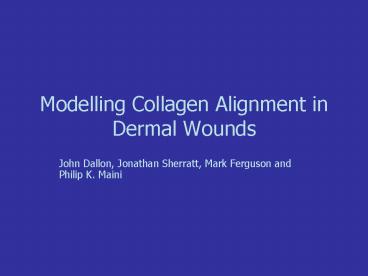Modelling Collagen Alignment in Dermal Wounds - PowerPoint PPT Presentation
1 / 40
Title:
Modelling Collagen Alignment in Dermal Wounds
Description:
where is again a time lag and N is the total number of cells ... shown and in (b) the collagen orientation ... fibrin network is represented by b (x,t) RESULTS ... – PowerPoint PPT presentation
Number of Views:104
Avg rating:3.0/5.0
Title: Modelling Collagen Alignment in Dermal Wounds
1
Modelling Collagen Alignment in Dermal Wounds
- John Dallon, Jonathan Sherratt, Mark Ferguson and
Philip K. Maini
2
Key Players
- Fibroblasts degrade fibrin
- secrete collagen
- Collagen slows down fibroblasts
- Fibroblasts lt ----------- gt collagen
- alignment
3
Alignment problems occur in a wide variety of
applicationscrystals, ecology, developmental
biology etcMathematical approaches
integro-partial-differential equations,discrete
orientation
4
The Orientation Model
VariablesCells discrete objects
paths given by fCollagen continuous vector
field denoted by c (x, t)
5
Where ? and s are positive constants with s
representating the cell speed and a time lag
where is again a time lag and N is the total
number of cells
6
(No Transcript)
7
Here ? is the angle of c, the vector representing
the collagen direction and a (x, t) is the angle
of f (x,t).
8
(No Transcript)
9
Fig. 3. The collagen orientations and cell
positions for a typical simulation. In (a) the
initial random collagen orientation is shown and
in (b) the collagen orientation is shown after
100 hr of remodelling by the fibroblasts on a
domain of 0.5 mm x 1.0 mm. The cells have a
speed of
and the numerical grid for the vector field is
51 x 101.
10
Fig.4. The effect of altering the rate at which
the fibroblasts change the fibre direction. It
is seen that as the influence of the cells on the
collagen orientation increases the pattern has
more structure in (a) where ? 20. The
simulations shown here have the same parameters
and set-up as that shown in Fig. 3.
11
(No Transcript)
12
(No Transcript)
13
(No Transcript)
14
(No Transcript)
15
The Tissue Regeneration Modelfibrin network is
represented by b (x,t)
16
(No Transcript)
17
(No Transcript)
18
(No Transcript)
19
(No Transcript)
20
(No Transcript)
21
(No Transcript)
22
RESULTS
23
- Altering the speed of fibroblasts increasing the
speed leads to greater alignment. Can be done
using a chemoattractant (Knapp et al, 1999 can
increase speed 3-fold (Ware et al, 1998)) or
altering the integrin expression levels of the
fibroblasts (Palecek et al, 1997)
24
- Reducing contact guidance inhibit the formation
of microtubules with colcemid (Oakley et al,
1997) treatment with colchicine (causes rounder
morphology (Mercier et al, 1996)
25
- Effects of initial collagen orientation
transplant pieces of tendon (Matsumoto et al,
1998) place pieces of oriented gel (Guido and
Tranquillo, 1993)
26
The effects of TGF-beta
27
- Altering the profile of transforming growth
factor beta can have profound effects on the
healing process, including significantly
increasing or decreasing the degree of scarring
(Shah et al, 1992, 1994, 1995, 1999)
28
Effects of TGF-beta
- Cell proliferation biphasic (depends on age)
- Cell motility biphasic effect on directed cell
movement (chemotaxis) - Collagen production increase collagen
production and decrease collagenase production - Cell reorientation development of lamellipodia
and filopodia depends on concentration levels
29
(No Transcript)
30
(No Transcript)
31
Model results
- Effects on cell proliferation, migration and
extracellular matrix production influence
collagen alignment in only a MINOR way - Regulation of filopodial extensions by TGF-beta
could be the CRUCIAL property
32
Interpretation
- Adding TGF-beta-3 causes more cell reorientation,
leads to less alignment and scarring is reduced - Antibodies to TGF-beta-1 and 2 would, in this
interpretation, lead to more alignment and hence
more scarring. CONTRADICTION - Both these isoforms bind to cells competitively
(Altomonte et al, 1996, Piek et al, 1999)
33
Model Extension
34
- Model considered wound is isolation.
- If we embed it in tissue we find that the
- time taken for the cells to enter and heal
- the wound is too long.
35
McDougall and Sherratt
- Add a chemoattractant produced in the
- wound (PDGF, IL-Ibeta, TNF-alpha)
- Reaction-diffusion equation at steady state
- Cells velocity now depends on size of
- chemical gradient and is in the direction
- of the gradient
36
- Fibroblast density is low at top and high
- at bottom (staining experiments)
37
RESULTS
- Wound heals in reasonable time
- Widely dispersed chemoattractant prolife leads to
greater degree of interdigitation (better linked) - Uniform cell distribution in the unwounded
- skin leads to parallel alignment rather
- than perpendicular alignment (w.r.t. bottom of
wound)
38
- Switching off the speed cue leads to fewer
- cells entering the wound. Orientation not
- altered
- Switching off the directional cue (but not
speed) is worse - Pattern of alignment depends crucially on
- the form taken for velocity dependence
39
Therapeutic aspects
- Decrease the sensitivity of fibroblast
- reorientation to chemoattractant gradients
- (add agent that binds competitively to
receptors mannose 6 phosphate acts in this way
Ferguson and OKane, 2004 - have shown this reduces scarring)
40
References
- J.C. Dallon, J.A. Sherratt, P.K. Maini,
J.theor.Biol., 199, 449-471 (1999) - J.C. Dallon, J.A. Sherratt, P.K. Maini, M.
Ferguson, - IMA J.Math.Appl.Biol.Med, 17, 379-393 (2000)
- J.C. Dallon, J.A. Sherratt, P.K. Maini, Wound
Repair and Regeneration, 9, 278-286 (2001) - S. McDougall, J. Dallon, J. Sherratt, PKM,
(submitted)































